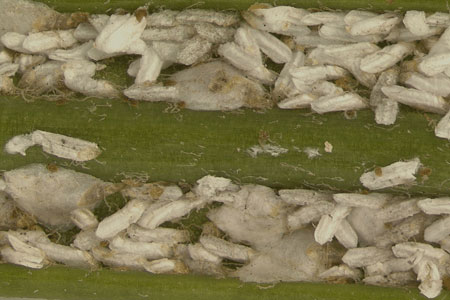Home » Bugs » Lawn Pests »
Active Seasons




Cycad Aulacaspis Scale Appearance and Size Facts
While they are devoid of any disease, cycad Aulacaspis scales are a rising threat to plants across south Florida. Although Florida homeowners might see this as a cause for alarm, there’s no need to panic. With help from Hulett Environmental Services, you can better detect signs of a potential infestation on your cycads and learn how to remove any current or future infestation threats, resulting in healthy and pretty Sago palms.
Here are some basic characteristics of cycad Aulacaspis scales to get started:
- Color: White-colored bodies, sometimes translucent
- Shape: Pear-shaped and elongated bodies
- Size: Males are 1/64 to 1/42 of an inch in length; females are 1/20 to 1/16 of an inch long
- Skin: Protected under a waxy cover composed of old shed skins
Identifying Cycad Aulacaspis Scales From Other Lawn Pests
One characteristic of cycad Aulacaspis scales that differentiates them from similar lawn pests is that when a plant is severely infested, the plant is nearly completely covered in a white waxy-like crust. However, when a plant infestation begins, since they are so small, it can be difficult to identify an infestation by yourself. If you’re struggling to properly identify if you have a cycad Aulacaspis scale infestation, contact professional pest control services for help.
We provide treatment for these pests in the following locations and their surrounding areas:

Behavior and Habitat of Cycad Aulacaspis Scales
Cycad Aulacaspis scales are more common on lower leaf surfaces than upper leaf surfaces and prefer hot and humid climates. In terms of their life spans, the development of eggs to mature adults takes about a month. Females can lay over 100 eggs that normally take one to two weeks to hatch. However, males outnumber females by a large margin.
They typically feed on plant fluids and can cause severe damage to these host plants. With their survival based on hot and plant-based environments, homeowners across southern Florida will find these pesky invaders to be an extra nuisance.

Signs of Infestation of Cycad Aulacaspis Scales
The first sign of a cycad Aulacaspis scale infestation is the presence of small yellow spots on your plants. As the infestation progresses, the yellow spots will turn brown and cause the plant to potentially die. In mass infestations, lower leaf surfaces will appear white, but they can be found in trunks, root systems and upper leaf surfaces as well.

Tips for Prevention of Cycad Aulacaspis Scales
The best way to prevent any type of armored scale is to inspect your plants thoroughly before planting or purchasing for any signs of an infestation. For plants already planted, do the same on roots and leaves. If you find any yellow spots or see an infestation occurring, don’t hesitate to find professional pest control. Routine lawn and ornamental maintenance service from a professional lawn care company is often the best way to help prevent infestation and damage in the first place.
Getting Rid of Cycad Aulacaspis Scales
Preventive measures can help but are not a guarantee you will avoid an infestation. Finding professional pest control services, such as the ones offered with Hulett, is your best option for removing cycad Aulacaspis scales from your south Florida plants and landscape. Whether you need residential pest control or commercial pest control, nothing beats going to the pros.
Effective Cycad Aulacaspis Scale Control Solutions
Don’t let your cycad Aulacaspis scale infestation grow when you can just call Hulett for help. With over 50 years of pest control and lawn care experience, our expert team of technicians will get to the root of your pest problem and not only remove it but prevent it from returning. To get the best pest control services in south Florida, schedule a free inspection online or give us a call today!

